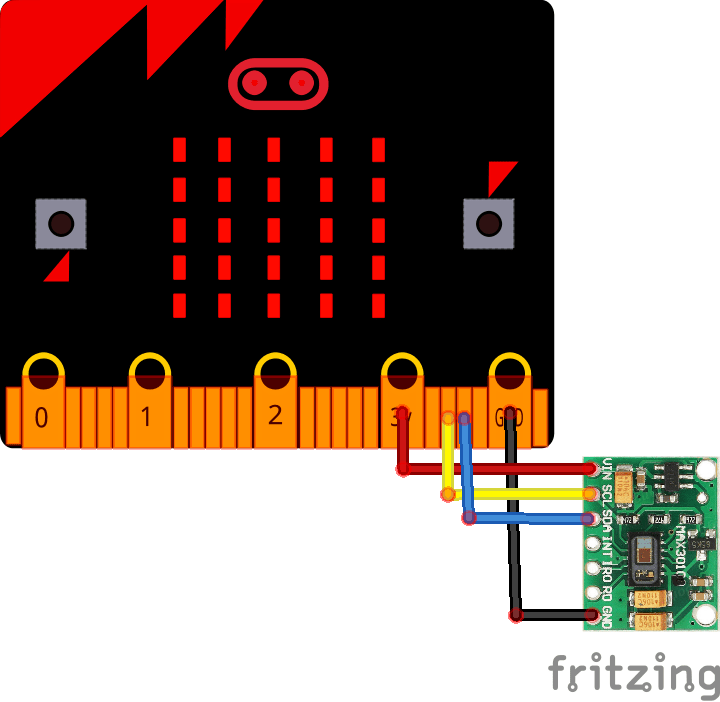The MAX30102 is an integrated pulse oximetry and heart-rate monitor biosensor module. It includes internal LEDs, photodetectors, optical elements, and low-noise electronics with ambient light rejection. The MAX30102 provides a complete system solution to ease the design-in process for mobile and wearable devices.
The MAX30102 operates on a single 1.8V power supply and a separate 5.0V power supply for the internal LEDs. Communication is through a standard I2C-compatible interface. The module can be shut down through software with zero standby current, allowing the power rails to remain powered at all times.
Key Features
Heart-Rate Monitor and Pulse Oximeter Biosensor in LED Reflective Solution
Tiny 5.6mm x 3.3mm x 1.55mm 14-Pin Optical Module
Integrated Cover Glass for Optimal, Robust Performance
Ultra-Low Power Operation for Mobile Devices
Programmable Sample Rate and LED Current for Power Savings
Low-Power Heart-Rate Monitor (< 1mW)
Ultra-Low Shutdown Current (0.7µA, typ)
Fast Data Output Capability
High Sample Rates
Robust Motion Artifact Resilience
High SNR
-40°C to +85°C Operating Temperature Range
Shopping List
This module will cost less than $2
| Amount | Part Type | |
|---|---|---|
| 1 | MAX30102 | |
| 1 | BBC micro:bit bulk micro-controller with motion detection, compass, LED display and Bluetooth |
Schematics/Layout

microbit and max30102
Code
Again we use a library and again its an sparkfun one – https://github.com/sparkfun/SparkFun_MAX3010x_Sensor_Library
[codesyntax lang=”cpp”]
#include <Wire.h>
#include "MAX30105.h"
#include "heartRate.h"
MAX30105 particleSensor;
const byte RATE_SIZE = 4; //Increase this for more averaging. 4 is good.
byte rates[RATE_SIZE]; //Array of heart rates
byte rateSpot = 0;
long lastBeat = 0; //Time at which the last beat occurred
float beatsPerMinute;
int beatAvg;
void setup()
{
Serial.begin(115200);
Serial.println("Initializing...");
// Initialize sensor
if (!particleSensor.begin(Wire, I2C_SPEED_FAST)) //Use default I2C port, 400kHz speed
{
Serial.println("MAX30105 was not found. Please check wiring/power. ");
while (1);
}
Serial.println("Place your index finger on the sensor with steady pressure.");
particleSensor.setup(); //Configure sensor with default settings
particleSensor.setPulseAmplitudeRed(0x0A); //Turn Red LED to low to indicate sensor is running
particleSensor.setPulseAmplitudeGreen(0); //Turn off Green LED
}
void loop()
{
long irValue = particleSensor.getIR();
if (checkForBeat(irValue) == true)
{
//We sensed a beat!
long delta = millis() - lastBeat;
lastBeat = millis();
beatsPerMinute = 60 / (delta / 1000.0);
if (beatsPerMinute < 255 && beatsPerMinute > 20)
{
rates[rateSpot++] = (byte)beatsPerMinute; //Store this reading in the array
rateSpot %= RATE_SIZE; //Wrap variable
//Take average of readings
beatAvg = 0;
for (byte x = 0 ; x < RATE_SIZE ; x++)
beatAvg += rates[x];
beatAvg /= RATE_SIZE;
}
}
Serial.print("IR=");
Serial.print(irValue);
Serial.print(", BPM=");
Serial.print(beatsPerMinute);
Serial.print(", Avg BPM=");
Serial.print(beatAvg);
if (irValue < 50000)
Serial.print(" No finger?");
Serial.println();
}
[/codesyntax]
Output
Open the serial monitor – this is what I saw, it took a little bit of time for the readings to appear
IR=111297, BPM=32.68, Avg BPM=64
IR=111451, BPM=32.68, Avg BPM=64
IR=111519, BPM=32.68, Avg BPM=64
IR=111557, BPM=85.35, Avg BPM=66
IR=111449, BPM=85.35, Avg BPM=66
IR=111513, BPM=85.35, Avg BPM=66
IR=111478, BPM=85.35, Avg BPM=66
Links
https://datasheets.maximintegrated.com/en/ds/MAX30102.pdf
Low Power MAX30102 Heart Rate Oxygen Pulse Breakout for Arduino

